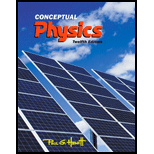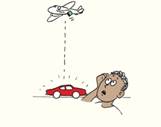
Conceptual Physics (12th Edition)
12th Edition
ISBN: 9780321909107
Author: Paul G. Hewitt
Publisher: PEARSON
expand_more
expand_more
format_list_bulleted
Textbook Question
Chapter 10, Problem 43RCQ
A heavy crate accidentally falls from a high-flying airplane just as it flies directly above a shiny red Porsche smartly parked in a car lot. Relative to the Porsche, where will the crate crash?

Expert Solution & Answer
Want to see the full answer?
Check out a sample textbook solution
Students have asked these similar questions
Imagine you are out for a stroll on a sunny day when you encounter a lake. Unpolarized light from the sun is reflected off the lake into your eyes. However, you notice when you put on your vertically polarized sunglasses, the light reflected off the lake no longer reaches your eyes. What is the angle between the unpolarized light and the surface of the water, in degrees, measured from the horizontal? You may assume the index of refraction of air is nair=1 and the index of refraction of water is nwater=1.33 . Round your answer to three significant figures. Just enter the number, nothing else.
Deduce what overvoltage is like in reversible electrodes.
pls help on these
Chapter 10 Solutions
Conceptual Physics (12th Edition)
Ch. 10 - Prob. 1RCQCh. 10 - Why does the vertical component of velocity for a...Ch. 10 - Prob. 3RCQCh. 10 - Prob. 4RCQCh. 10 - Prob. 5RCQCh. 10 - Prob. 6RCQCh. 10 - A projectile is launched upward at an angle of 70°...Ch. 10 - A projectile is launched vertically at 100 m/s. If...Ch. 10 - Prob. 9RCQCh. 10 - How does Earth’s curvature relate to the speed...
Ch. 10 - Prob. 11RCQCh. 10 - Prob. 12RCQCh. 10 - Prob. 13RCQCh. 10 - Prob. 14RCQCh. 10 - Prob. 15RCQCh. 10 - Prob. 16RCQCh. 10 - Prob. 17RCQCh. 10 - Who gathered the data that showed planets...Ch. 10 - Prob. 19RCQCh. 10 - Prob. 20RCQCh. 10 - Prob. 21RCQCh. 10 - Prob. 22RCQCh. 10 - Prob. 23RCQCh. 10 - Prob. 24RCQCh. 10 - Prob. 25RCQCh. 10 - A ball is thrown horizontally from a cliff at a...Ch. 10 - Prob. 27RCQCh. 10 - Prob. 28RCQCh. 10 - A baseball projected with an initial velocity of...Ch. 10 - Students in the lab (see Figure 10.5) measure the...Ch. 10 - Prob. 31RCQCh. 10 - Prob. 32RCQCh. 10 - Prob. 33RCQCh. 10 - A horizontally moving tennis ball barely clears...Ch. 10 - Prob. 35RCQCh. 10 - Prob. 36RCQCh. 10 - Prob. 37RCQCh. 10 - Prob. 38RCQCh. 10 - Prob. 39RCQCh. 10 - Prob. 40RCQCh. 10 - Prob. 41RCQCh. 10 - Prob. 42RCQCh. 10 - A heavy crate accidentally falls from a...Ch. 10 - Prob. 44RCQCh. 10 - 45. Fragments of fireworks beautifully illuminate...Ch. 10 - In the absence of air resistance, why doesn’t the...Ch. 10 - Prob. 47RCQCh. 10 - Prob. 48RCQCh. 10 - Two golfers each hit a ball at the same speed, but...Ch. 10 - A park ranger shoots a monkey hanging from a...Ch. 10 - A projectile is fired straight upward at 141 m/s....Ch. 10 - Prob. 52RCQCh. 10 - Prob. 53RCQCh. 10 - Prob. 54RCQCh. 10 - Prob. 55RCQCh. 10 - Prob. 56RCQCh. 10 - Prob. 57RCQCh. 10 - Prob. 58RCQCh. 10 - Prob. 59RCQCh. 10 - Prob. 60RCQCh. 10 - Prob. 61RCQCh. 10 - Prob. 62RCQCh. 10 - Prob. 63RCQCh. 10 - Ignoring air resistance, could a satellite be put...Ch. 10 - Prob. 65RCQCh. 10 - Prob. 66RCQCh. 10 - Prob. 67RCQCh. 10 - Prob. 68RCQCh. 10 - Prob. 69RCQCh. 10 - Prob. 70RCQCh. 10 - Prob. 71RCQCh. 10 - Prob. 72RCQCh. 10 - Prob. 73RCQCh. 10 - Prob. 74RCQCh. 10 - Prob. 75RCQCh. 10 - Prob. 76RCQCh. 10 - What is the advantage of launching space vehicles...Ch. 10 - Prob. 78RCQCh. 10 - What is the maximum possible speed of impact on...Ch. 10 - Prob. 80RCQCh. 10 - Prob. 81RCQCh. 10 - At what point in its elliptical orbit about the...Ch. 10 - Prob. 83RCQCh. 10 - Prob. 84RCQCh. 10 - Prob. 85RCQCh. 10 - Prob. 86RCQCh. 10 - Prob. 87RCQCh. 10 - Prob. 88RCQCh. 10 - Prob. 89RCQCh. 10 - Prob. 90RCQCh. 10 - Prob. 91RCQCh. 10 - Prob. 92RCQCh. 10 - 93. Which two planets are never seen at midnight,...Ch. 10 - Prob. 94RCQCh. 10 - Prob. 95RCQCh. 10 - Prob. 96RCQCh. 10 - Prob. 97RCQCh. 10 - Prob. 98RCQCh. 10 - Prob. 99RCQCh. 10 - Prob. 100RCQ
Knowledge Booster
Learn more about
Need a deep-dive on the concept behind this application? Look no further. Learn more about this topic, physics and related others by exploring similar questions and additional content below.Similar questions
- pls help on thesearrow_forward20. Two small conducting spheres are placed on top of insulating pads. The 3.7 × 10-10 C sphere is fixed whie the 3.0 × 107 C sphere, initially at rest, is free to move. The mass of each sphere is 0.09 kg. If the spheres are initially 0.10 m apart, how fast will the sphere be moving when they are 1.5 m apart?arrow_forwardpls help on allarrow_forward
- 19. Mount Everest, Earth's highest mountain above sea level, has a peak of 8849 m above sea level. Assume that sea level defines the height of Earth's surface. (re = 6.38 × 106 m, ME = 5.98 × 1024 kg, G = 6.67 × 10 -11 Nm²/kg²) a. Calculate the strength of Earth's gravitational field at a point at the peak of Mount Everest. b. What is the ratio of the strength of Earth's gravitational field at a point 644416m below the surface of the Earth to a point at the top of Mount Everest? C. A tourist watching the sunrise on top of Mount Everest observes a satellite orbiting Earth at an altitude 3580 km above his position. Determine the speed of the satellite.arrow_forwardpls help on allarrow_forwardpls help on allarrow_forward
- 6. As the distance between two charges decreases, the magnitude of the electric potential energy of the two-charge system: a) Always increases b) Always decreases c) Increases if the charges have the same sign, decreases if they have the opposite signs d) Increases if the charges have the opposite sign, decreases if they have the same sign 7. To analyze the motion of an elastic collision between two charged particles we use conservation of & a) Energy, Velocity b) Momentum, Force c) Mass, Momentum d) Energy, Momentum e) Kinetic Energy, Potential Energyarrow_forwardpls help on all asked questions kindlyarrow_forwardpls help on all asked questions kindlyarrow_forward
arrow_back_ios
SEE MORE QUESTIONS
arrow_forward_ios
Recommended textbooks for you
 Glencoe Physics: Principles and Problems, Student...PhysicsISBN:9780078807213Author:Paul W. ZitzewitzPublisher:Glencoe/McGraw-Hill
Glencoe Physics: Principles and Problems, Student...PhysicsISBN:9780078807213Author:Paul W. ZitzewitzPublisher:Glencoe/McGraw-Hill Principles of Physics: A Calculus-Based TextPhysicsISBN:9781133104261Author:Raymond A. Serway, John W. JewettPublisher:Cengage Learning
Principles of Physics: A Calculus-Based TextPhysicsISBN:9781133104261Author:Raymond A. Serway, John W. JewettPublisher:Cengage Learning University Physics Volume 1PhysicsISBN:9781938168277Author:William Moebs, Samuel J. Ling, Jeff SannyPublisher:OpenStax - Rice University
University Physics Volume 1PhysicsISBN:9781938168277Author:William Moebs, Samuel J. Ling, Jeff SannyPublisher:OpenStax - Rice University College PhysicsPhysicsISBN:9781305952300Author:Raymond A. Serway, Chris VuillePublisher:Cengage Learning
College PhysicsPhysicsISBN:9781305952300Author:Raymond A. Serway, Chris VuillePublisher:Cengage Learning Classical Dynamics of Particles and SystemsPhysicsISBN:9780534408961Author:Stephen T. Thornton, Jerry B. MarionPublisher:Cengage Learning
Classical Dynamics of Particles and SystemsPhysicsISBN:9780534408961Author:Stephen T. Thornton, Jerry B. MarionPublisher:Cengage Learning Physics for Scientists and Engineers: Foundations...PhysicsISBN:9781133939146Author:Katz, Debora M.Publisher:Cengage Learning
Physics for Scientists and Engineers: Foundations...PhysicsISBN:9781133939146Author:Katz, Debora M.Publisher:Cengage Learning

Glencoe Physics: Principles and Problems, Student...
Physics
ISBN:9780078807213
Author:Paul W. Zitzewitz
Publisher:Glencoe/McGraw-Hill

Principles of Physics: A Calculus-Based Text
Physics
ISBN:9781133104261
Author:Raymond A. Serway, John W. Jewett
Publisher:Cengage Learning

University Physics Volume 1
Physics
ISBN:9781938168277
Author:William Moebs, Samuel J. Ling, Jeff Sanny
Publisher:OpenStax - Rice University

College Physics
Physics
ISBN:9781305952300
Author:Raymond A. Serway, Chris Vuille
Publisher:Cengage Learning

Classical Dynamics of Particles and Systems
Physics
ISBN:9780534408961
Author:Stephen T. Thornton, Jerry B. Marion
Publisher:Cengage Learning

Physics for Scientists and Engineers: Foundations...
Physics
ISBN:9781133939146
Author:Katz, Debora M.
Publisher:Cengage Learning
Time Dilation - Einstein's Theory Of Relativity Explained!; Author: Science ABC;https://www.youtube.com/watch?v=yuD34tEpRFw;License: Standard YouTube License, CC-BY